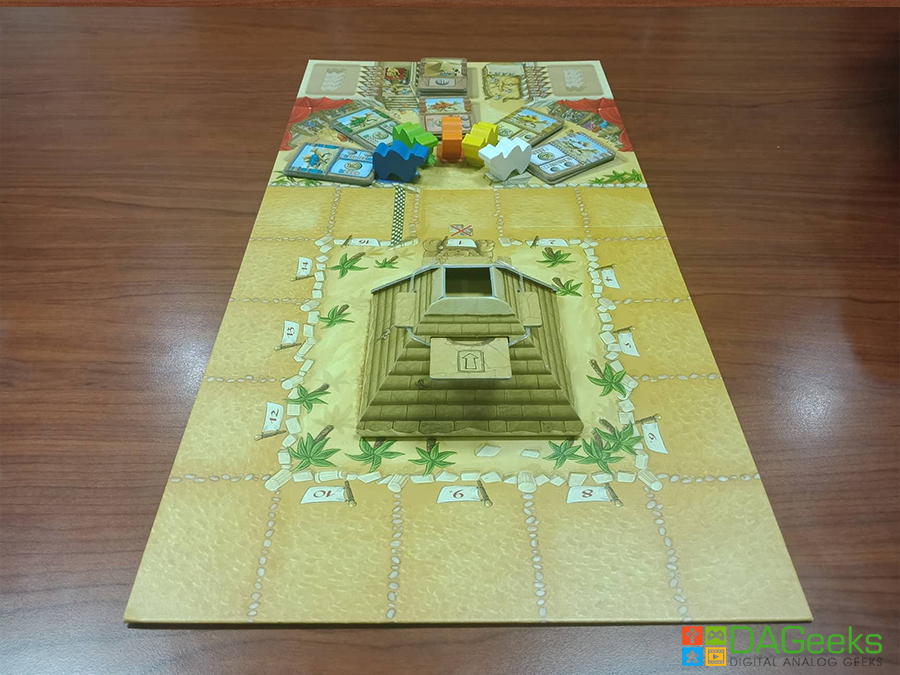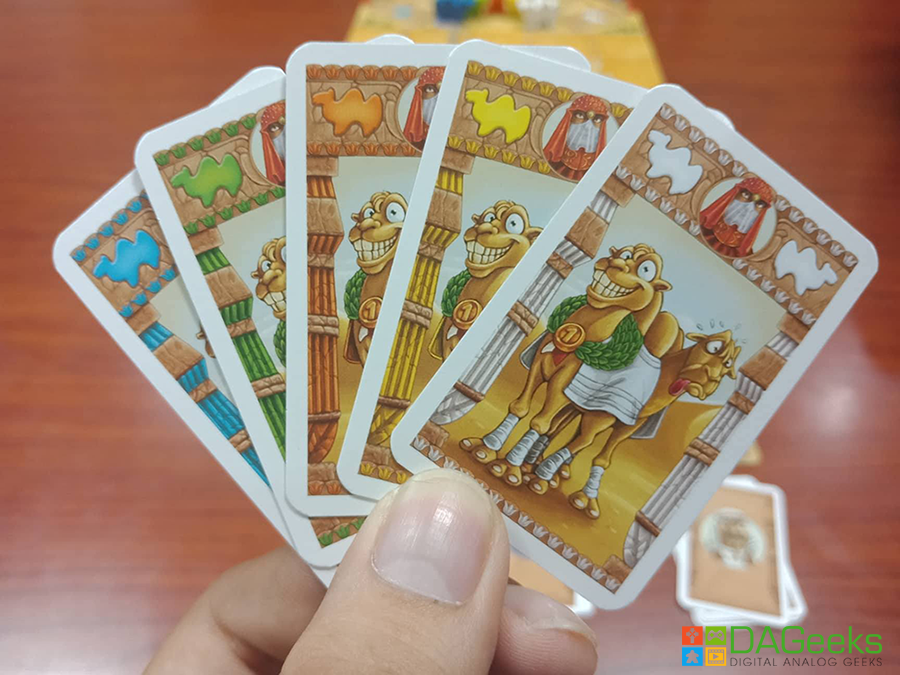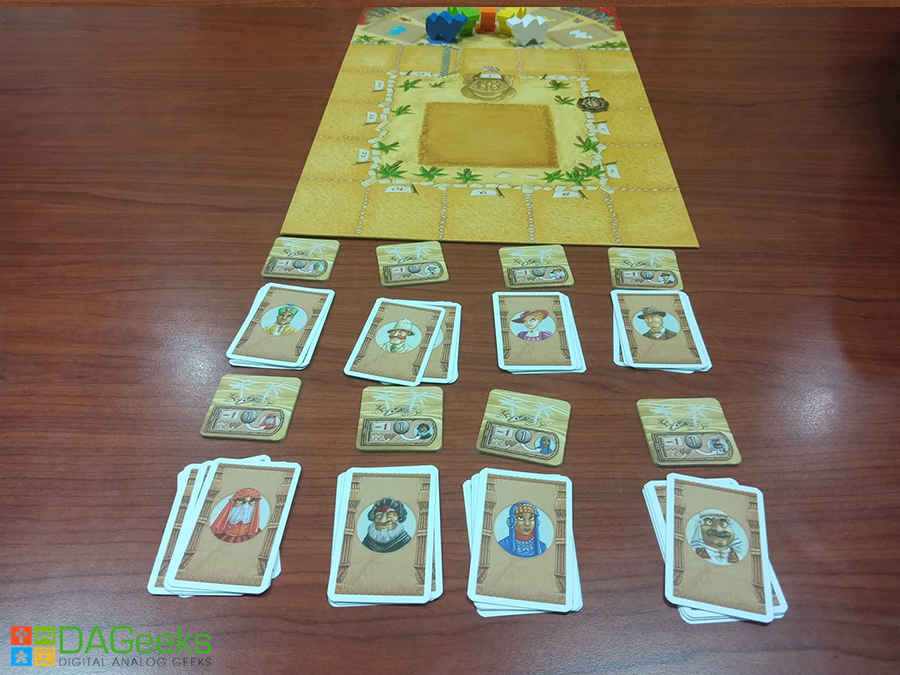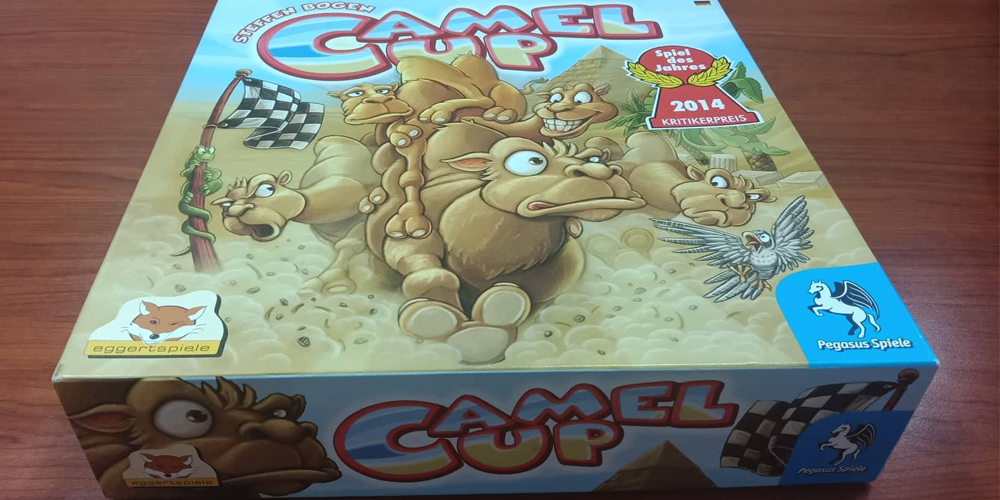Camel Up or Camel Cup as others would call it, both are correct, is a game about camel racing. The first thing I have to say so that there is no confusion at all during the course of this review.
NO, this is not about you racing camels. You are not riding the camels, or the owner of the camels. You as the player are gamblers, and betting on the outcome of the race, kinda like horse races, but with camels.

Now that I’ve gotten that off my chest, I can continue with the review. Camel Up is a 3-8 player gambling game where players will bet on 5 camels trying to predict the outcome of the race, gaining Egyptian Pounds in the process.
Components
- 1 game board
- 5 wooden camels
- 1 dice pyramid
- 5 wooden dice
- 40 betting cards
- 8 desert tiles
- 15 stage betting tiles
- 5 pyramid tiles
- 20 money cards
- 50 coins
- 1 start player marker
The dice pyramid, along with the tiles, and coins all come in a thick cardboard frame, simple and sturdy considering the amount of times these things will be handled.The dice pyramid comes in 4 pieces and an elastic band, and is very easy to build following the simple and easy to understand instructions in the rule book. This is used to shake, rattle, & roll the 5 dice inside it, one at a time.
Setup
The game is very easy to set up, as the game makes it very clear where each set of tiles goes onto. the 5 pyramid tiles goes near the edge of the board. The leg betting tiles goes on the slots behind each of their corresponding camel’s tents, and the Pyramid goes on the square in the middle of the race track. The coins and bills can be set to the side where everyone can reach. The starting player marker will be given to a player of everyone’s choosing.

Each player will then choose a character, and take their corresponding camel cards, and oasis/mirage tiles, those that were not picked go back into the box, along with that they will also each receive 3 Egyptian pounds(EP).
Gameplay
The goal of Camel Up is to have earned the most money by the end of the race, which happens once one of the camels has crossed the finish line. On each player’s turn they will be able to do 1 of 4 actions: Take a Pyramid tile, Take a Leg Betting tile, Place a mirage/oasis tile, or Bet on the overall winner or loser of the race.
Taking a Pyramid tile is easy and very simple, and probably the most used action in the game. When you take a pyramid tile, this ensures the player that they will receive 1 EP at the end of the leg and also the player must take the dice pyramid, shake it, place it with the opening on the surface and press the switch. This ensures that only 1 die will come out at a time, and is also good for building suspense. Once the die is rolled just move the corresponding camel that many spaces, stacking on other camels if it lands in the same space as another camel.
Taking a Leg betting tile, is the primary way a player gains money in the game. For each camel there are 3 tiles, each differing with the prize for 1st place being 5, 3, and 2 EP, if their camel comes in 2nd they get 1 EP, and if its in 3rd, 4th, or 5th they lose 1EP. A player may take more than 1, and can even take the same color should they choose at the risk of losing more or gaining more money.

Placing an Oasis/Mirage tile is how players can manipulate the playing field to either make sure a camel stays in first or a camel stays in last. As I said before each player is given an Oasis/Mirage tile with their character’s face on it. The rules for placing them on the track are; They cannot be adjacent to another oasis/mirage tile(this is to prevent infinite loops), and of course cannot be placed on a square a camel is already on. There are 2 sides to the tile, The oasis which can move a camel forward 1 and on top of any camels in the next space, and the mirage which moves a camel back 1 and under any camels in that space. If you have already placed your tile, you may choose to move it to another place on the board, and even change it to the other side of the tile. As a bonus, any time a camel lands on your tile you gain 1EP, meaning you can earn a max of 5EP in a leg.
Betting on the overall winner/loser is probably the part everyone will know to do in this game, since it is the premise of the game to bet on the outcome of the race. Players will use their camel cards and place 1 of them face down on either the loser space or the winner space depending on what they think will be the outcome. Of course just betting on the winner doesnt mean you’ll all get the same winnings. At the end of the race the cards will be revealed starting from the bottom of the pile, the first correct prediction gets 8EP, the next is 5, then 3, 2, and 1. Any correct bets after that gain nothing, also all the wrong bets lose 1EP instead.

Once all the pyramid tiles have been taken, and the last die is rolled the leg is finished. Players will receive their winnings for their leg betting tiles, return all the tiles to their corresponding places, including the oasis/mirage tiles, place all the dice back into the pyramid to start the next leg of the game, and move the starting player marker to the left. This goes on until the end of the race where there will be a final giving out of winnings for the leg, as well as the overall bets.
Conclusion
When I find games that can accommodate this many players at a time, Usually as a rule of thumb I think that the sweet spot for a good game is around 4-6 players. This game is an exception, and is actually the most fun at the max 8 players. The more players there are makes each player value their actions, and even have to make more uninformed bets leaving the game to chance. Lots of the times we found ourselves cheering for different camels, hearts beating rapidly as we waited for someone to lift the pyramid and show us what was rolled, hearing lots of cheering and some even screaming because of the wrong bets made. Though the game can be a bit difficult to teach especially with the terms leg betting and overall betting, once that’s out of the way all bets are off and the game becomes the most fun you’ll ever have.


